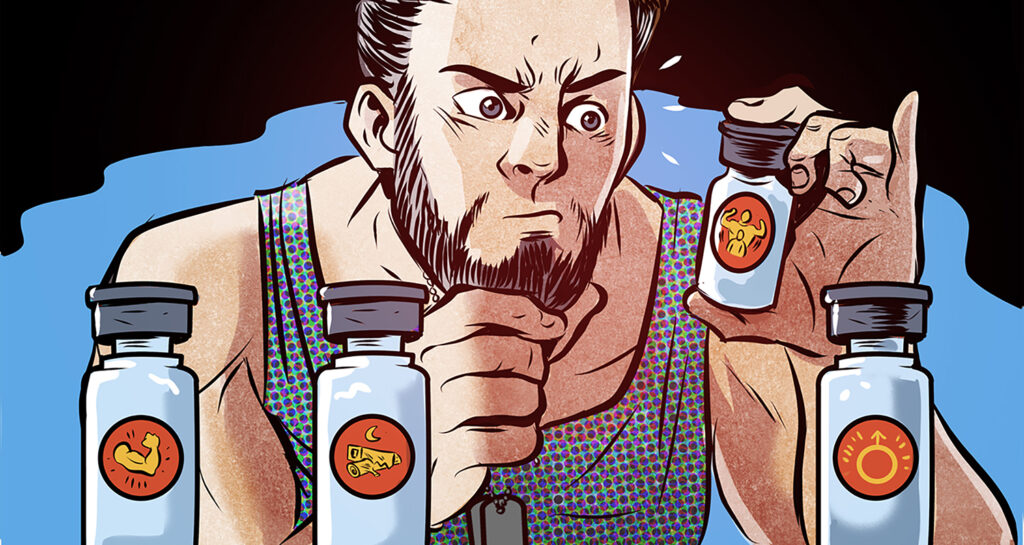Juan Leija, 38, had a problem: he was a personal trainer and a serious lifter whose elbow pain prevented him from doing some of the most fundamental lifts. “I’d been dealing with tendinitis for a year,” he remembers, “but it had been extreme for about six months. It felt like there was something broken in there.”
Just as Leija was starting to worry about his ability to train, a friend of his who owns a wellness clinic told him about something called BPC-157. It’s an injectable peptide compound that, his friend said, could do for Leija’s elbow what a year of conventional and alternative therapies couldn’t: make the pain go away.
“I went home and looked it up,” Leija says. Evidence was scarce, but enthusiasm wasn’t. Satisfied users – athletes, fighters, soldiers and gym rats among them – referred to it as the Wolverine peptide for its healing powers.
BPC-157 is part of a growing list of compounds called peptides gaining interest in fitness, wellness and anti ageing circles. The buzz comes from their supposed potential to help you build muscle, cut fat, sleep better or, with peptide PT-141, rekindle sexual desire – all without the side effects of riskier, more powerful options like testosterone and synthetic growth hormone.
Some peptide names, like MK-677, sound like secret mind-control experiments. Others, like sermorelin, look like they exist only to trip up 12-year-olds in a spelling bee. But what are peptides? Why are so many people suddenly promoting them? And do they even work?

The Promise of Peptides
“Peptides are short chains of amino acids,” says Ryan Greene, the chief medical officer of Monarch Athletic Club in West Hollywood, California. Your body actually produces more than 7000 of them, all with specific duties: regulating your metabolic health, your appetite, your body’s natural growth hormone.
There’s a perception now in gym culture that injecting peptides, albeit ones made in a lab, is a safer way to go about getting gains than taking human growth hormone (hGH) and/or anabolic steroids. But the sales pitch isn’t new. Antiaging clinics have been pushing the same promise of looks and performance since the late 20th century.
What’s new is the price, says Dr Graham Simpson, a physician with Opt Health, a telemedicine clinic that offers peptides. For instance, instead of paying more than $1000 a month for shots of growth hormone – the original fountain of youth – you’d pay more like a couple of hundred a month for peptides that stimulate your body to release its own growth hormone. Or you’d pay for peptides believed to stimulate tissue-healing cells.
The appeal is so strong that people are injecting the stuff daily or a few times a week. Simpson regards these treatments as “reasonable things we can do to [increase] our health span and life span.” Dr Jeremie Walker, Simpson’s colleague at Opt Health, agrees: “They’re mimicking what your body already does but with more specificity. It’s the difference between using a hammer and a scalpel.”
What the Science Says
In Australia, certain peptides can be obtained legally only with a doctor’s prescription and therefore can’t be advertised. For all the supposed benefits of these peptide injections, the FDA in the US hasn’t approved any of the ones we’ve mentioned to improve sexual function, enhance healing or slow aging. The World Anti-Doping Agency has banned BPC-157 and any growth-hormone-releasing peptides, too, which means no athlete competing in a drug-tested sport should go near them. WADA’s ban suggests that they could confer an advantage – which also means there just may be something to them.
Yet when you go looking for the scientific research, you don’t come up with a lot. One study on BPC-157 showed accelerated healing in rat tendon tissue. Another study, on MK-677, published in the Journal of Clinical Endocrinology & Metabolism, showed it boosted growth-hormone levels in real live older folks to the normal range found in young adults. But the kind of large-scale clinical trials you depend on to know whether something’s worth it? Not there yet.
Proponents argue that peptides are relatively low-risk. They’re made of amino acids; the theory is that if your body doesn’t need them for a specific use, they can be broken down and used for something else, Greene says.
“The appeal is so strong that people are injecting the stuff daily or a few times a week”
But low risk doesn’t mean zero risk. If you’re constantly stimulating your body over time to produce its own growth hormone, Greene ponders, “is there a potential risk for something similar to what you see with synthetic growth hormone? I think yeah, absolutely.” Known side effects of taking synthetic hGH on its own include increased risk of certain cancers and diabetes.
And beyond the possible health risks, the peptide industry is a target-rich environment for scammers. “The current state of affairs is pretty messy in the peptide world,” Walker acknowledges. “I kind of liken it to what we’re going through with cryptocurrency and the legacy financial system.” Opt Health doctors use phrases like “buyer beware”, “nascent industry” and “kind of rogue right now”. In the US, peptides prescribed by wellness clinics are made and sold by compounding pharmacies with minimal standardisation.
If that sounds scary to you, you’re not alone. Take endocrinologist Karl Nadolsky. He’s a former NCAA Division I wrestler and a self-described “meathead in the gym, but with a focus on health”. He cautions: “I would never personally take or suggest anyone take any of these peptides without clear clinical evidence for benefit in treating a disease,” he says. Greene says that if you do take them, you should do so only under a doctor’s supervision so they can do regular check-ins and blood work.
A Shot of Reality
Which brings us back to Juan Leija, the personal trainer who turned to BPC-157 to deal with his worsening elbow pain. Consistent with Greene’s advice, he went to a doctor for a prescription.
And it worked. “I would say within two or three weeks, the pain in my elbow started going away,” Leija says. “Five weeks in, it wasn’t there anymore.” He’s been using it ever since, injecting the peptide in his abdomen five days a week. He considers the cost of the treatment to be money well spent.
Obesity specialist Spencer Nadolsky, on the other hand, had a very different experience with the same peptide. For all the scepticism he shares with his endocrinologist brother, Karl, he bought BPC-157 from a compounding pharmacy in an attempt to alleviate his own tendinitis. And? “I didn’t get shit for results.”
Anecdotes won’t stop a lot of guys. “Many bodybuilders consider themselves on par with lab rats,” says Rick Collins, a lawyer who specialises in cases involving steroids and dietary supplements. “They have a much different threshold from the average person. If they’re hurt now, they can’t wait for FDA approval.”
But popularity shouldn’t be mistaken for a prescription. Only evidence can fill that.
The Peptide Codex
These four popular peptides promise quick fixes. But there are other, science-tested ways to go about getting their benefits.
| Name | The Hope | Do This Instead |
| BPC-157 | Accelerates healing and workout recovery. | If you’re not recovering from a workout quickly, Greene says, “my first question is, ‘Why?’ How’s your hydration, how’s your sleep?’ If all those things are on point, it could be age or the type of training you’re doing.” For tendons, platelet-rich-plasma therapy, in which your platelets are concentrated and injected to promote healing, is pricey but proven. |
| MK-677 | Increases muscle mass and reduces fat. | Lift consistently, progressively and with enough effort to get bigger and stronger. Eat protein-rich meals to give your body what it needs to build and repair muscle. Supplementing with creatine may also help. |
| PT-141 | Increases sexual function and arousal. | Keep blood flow strong by eating a heart-healthy diet, exercising regularly, quitting smoking and, of course, trying pharma (Viagra, Cialis, Levitra and other ED pills). |
| Sermorelin | Preserves muscle tissue and slows down signs of ageing. | You can increase natural-growth-hormone production by fasting, getting a good night’s sleep (growth-hormone levels are highest when you sleep), working out (high-intensity exercise seems to work best), losing excess body fat and limiting sugar and other refined carbs. |
















